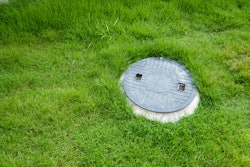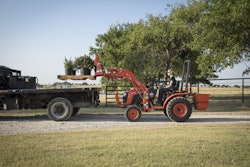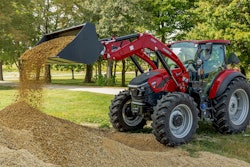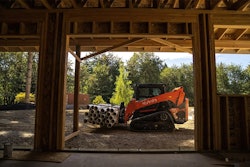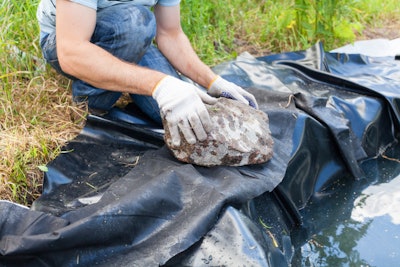

If you have customers interested in having a pond installed in their landscape, take a look at a few recommendations from Aquascape on building a pond, as well as choosing a location, filtration system and more.
Location and access
Before you begin the process of installing a pond for your customer, keep in mind that there are a few aspects that are commonly overlooked in the planning process.
Take stock of the location of where your customer wants the pond installed and decide if it’s really the best placement. Often times, customers will ask to have ponds installed in an area of the landscape that’s unused or in a lower area that will collect a fair amount of water, but both of these can ultimately be poor choices.
When an area of the yard goes unused, there’s usually a reason, so it seems pretty silly to put such a focal point of the landscape in a place where no one really goes. Typically speaking, if it’s out of sight and out of mind, there’s a good chance it won’t be cared for regularly.
Low spots in the yard are challenging to build in, and since there will be excess runoff water and pollutants going into the area, the water quality will suffer greatly.
Another thing to keep in mind when preparing for a pond installation is that you don’t want to make the pond too small, even though it may end up being easier to construct. Overall, it will be harder to maintain, however.
Steep and shallow
When digging a deeper pit without adding provisions for shallow areas, stacking stones on the inside of the pond can prove difficult. The excavation will be unstable and since there aren’t any shallow areas, it can be both dangerous and difficult to get in and out of the pond for maintenance purposes.
Additionally, there won’t be any ledges or plant life, as the majority of them will grow in less than 12” of water. With no ledges, it becomes difficult to disguise a bowl-shaped pond with rocks since gravel will slide towards the deeper areas and boulders would take up too much space.
Another mistake commonly made is making the pond too shallow. If your customers want to have fish in their pond, digging it too shallow will keep the fish from being able to over-winter in the North, and for those in the South, having it too shallow won’t allow the pond to stay cool enough for the fish.
Proper filtration
Some customers might operate under the incorrect assumption that their backyard pond doesn’t need a filter, as natural ponds and streams function just fine without them, but this is incorrect, as they are both very different in terms of hydrology.
According to Aquascapes, there are three types of pond filters: biological, mechanical and chemical/sterilizer.
Biological filters will work by breaking down pond wastes and converting them into compounds that are less harmful and can be used as fertilizer for any aquatic plants.
In biological filtration, Aquascapes says, nitrifying and facultative bacteria will absorb ammonia and turn nitrites into nitrates. If your customers want this type of filter, be sure to let them know that it will need to run 24/7 because if the pump shuts down, the bacteria can quickly use up the oxygen and die.
Mechanical filters will trap and remove sediment and debris, which will keep the water clean. Typical examples of mechanical filters are skimmers and pre-filters for pumps. Since these filter types will remove larger particles of waste, they will need to be cleaned more frequently. Under the umbrella of mechanical filters comes sedimentation and skimmer filters.
Sedimentation filters will allow particles that are heavier than water to go to the bottom of the pond where they will be removed through a filter that’s hooked to the bottom of the drain. Since they only remove larger particles, they have to be installed where they can be fed by gravity.
In the realm of skimmers, there are both box and floating options, and both will filter the water by removing waste and floating debris before it goes to the bottom of the pond.
Sterilizers will pass water through a tube that houses an ultraviolet bulb, which will kill living microscopic particles in the water. This type of filter is used to clear up algae blooms that will cause green water and they will control parasites.
If your customers want to go this route, be sure to let them know that they will need multiple sterilizers in order to be effective, which can prove to be a more expensive option. The bulbs will also have to be replaced every six to eight months because they will lose their effectiveness.
Underlayment and liners
Before installing the liner, you’ll need to choose an underlayment to install, as this will help prevent any punctures that may occur from the ground underneath.
There are plenty of materials that have been used as underlayment, according to Aquascape, but their recommendation lies with material that is easy to use, cost effective and readily available, such as a non-woven geotextile fabric.
Not only does the underlayment provide protection from rough underlying surfaces, but it also allows the ground to breathe from underneath, according to Aquascapes. Having this fabric down can help natural gases to escape from under the liner instead of being trapped, which can then cause gas bubbles in the liner to push up into the pond.
Another factor to keep in mind is the pond’s liner, and Aquascape experts say to never even consider using a liner if it doesn’t come with a long-term warranty.
While weathering can eventually take a toll on most liners, even ones with warranties, the sun is the primary cause of deterioration in most pond liners. If the pond is built properly with gravel and boulders covering the liner, Aquascape says the liner will be better protected from the sun and its lifespan should be extended beyond the warranty time.
If your customers have expressed an interest in having fish in their pond, it’s also extremely important to make sure the liner you’ve chosen is fish-friendly. You can find this out by checking with the manufacturer to see if it’s been cleared as safe for fish. If the liner has this stamp of approval, it should guarantee that the membrane is chemically compounded to be safe for fish, and it will have been tested and verified to ensure it’s non-toxic to fish.
Check out a few different liner options recommended by Aquascape here.
Check back tomorrow for part 2 of this series, where we’ll take a look at pond ecology, adding in rock and gravel and more.



